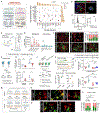Treg cell-derived osteopontin promotes microglia-mediated white matter repair after ischemic stroke
- PMID: 34015256
- PMCID: PMC8282725
- DOI: 10.1016/j.immuni.2021.04.022
Treg cell-derived osteopontin promotes microglia-mediated white matter repair after ischemic stroke
Abstract
The precise mechanisms underlying the beneficial effects of regulatory T (Treg) cells on long-term tissue repair remain elusive. Here, using single-cell RNA sequencing and flow cytometry, we found that Treg cells infiltrated the brain 1 to 5 weeks after experimental stroke in mice. Selective depletion of Treg cells diminished oligodendrogenesis, white matter repair, and functional recovery after stroke. Transcriptomic analyses revealed potent immunomodulatory effects of brain-infiltrating Treg cells on other immune cells, including monocyte-lineage cells. Microglia depletion, but not T cell lymphopenia, mitigated the beneficial effects of transferred Treg cells on white matter regeneration. Mechanistically, Treg cell-derived osteopontin acted through integrin receptors on microglia to enhance microglial reparative activity, consequently promoting oligodendrogenesis and white matter repair. Increasing Treg cell numbers by delivering IL-2:IL-2 antibody complexes after stroke improved white matter integrity and rescued neurological functions over the long term. These findings reveal Treg cells as a neurorestorative target for stroke recovery.
Keywords: microglia; oligodendrocytes; osteopontin; regulatory T cells; stroke recovery; white matter.
Copyright © 2021 Elsevier Inc. All rights reserved.
Conflict of interest statement
Declaration of interests The authors declare no competing interests.
Figures






Comment in
-
T cells direct microglial repair of white matter after stroke.Trends Neurosci. 2021 Oct;44(10):769-770. doi: 10.1016/j.tins.2021.07.005. Epub 2021 Jul 28. Trends Neurosci. 2021. PMID: 34332802
References
Publication types
MeSH terms
Substances
Grants and funding
LinkOut - more resources
Full Text Sources
Other Literature Sources
Medical
Molecular Biology Databases
Research Materials

